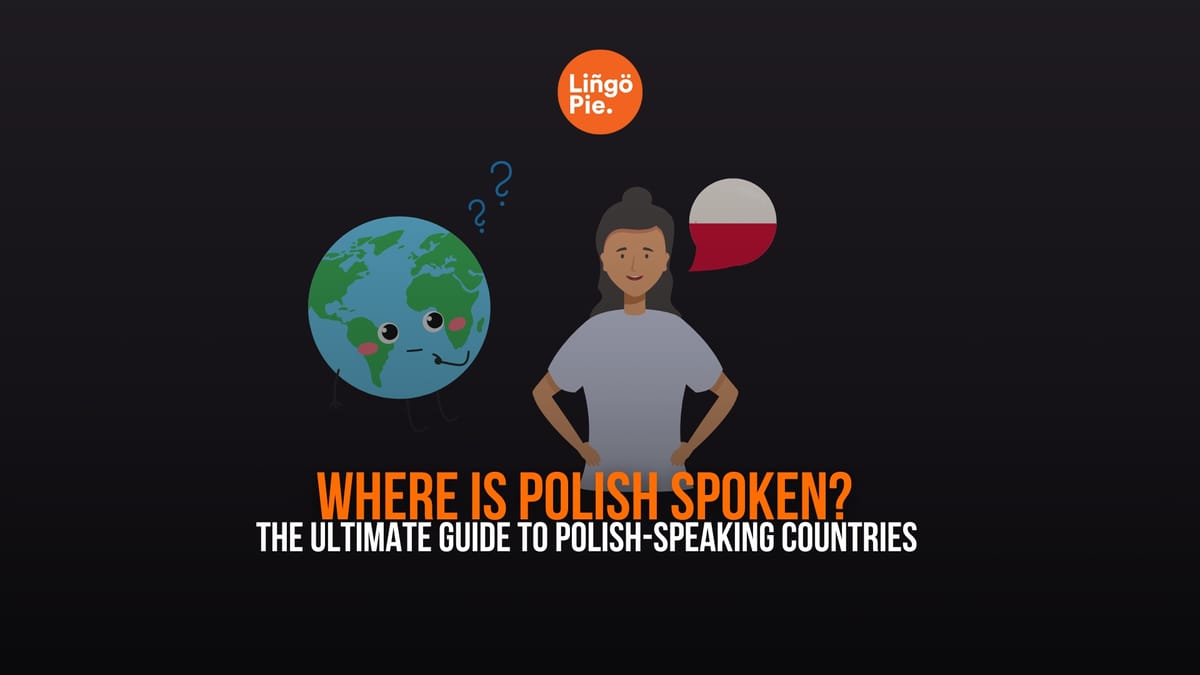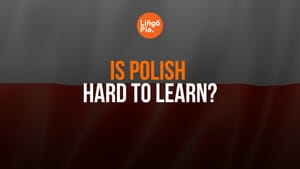Polish is the national language of Poland. That part’s easy. What most people don’t expect is just how far it reaches beyond those borders. Polish is one of the most widely spoken Slavic languages, with speakers scattered across Europe, the Americas, and even Australia. Some learned it from their parents. Others picked it up in school. In some places, it’s protected by law. In others, it lives quietly in kitchens, churches, and neighborhood shops.
If you’re wondering where Polish is spoken, which countries speak It, or how Polish communities have kept the language alive worldwide, you’re in the right place! In this guide, we’ll explore:
- Which countries speak Polish today
- Why Polish is still spoken across Europe and beyond
- How you can learn Polish effectively—even as a beginner
Whether you're curious about your heritage, moving to a Polish-speaking area, or just love learning languages, this is your complete guide to the global presence of the Polish language.
- How To Say Hello In Polish? 12 Easy Ways
- 13 Must-Know Polish Traditions For Your Next Trip
- How to Improve Your Polish Conversation Skills [Tips]

What Language Do Polish People Speak?
Polish people speak Polish, which is part of the West Slavic group of languages. It shares similarities with Czech and Slovak but has its own distinct rules and sound system. Polish uses a Latin-based alphabet with unique diacritical marks (like ł, ś, ź) that change pronunciation significantly.
The language is characterized by:
- A highly inflected grammar with seven cases and three genders (masculine, feminine, neuter)
- A rich vocabulary influenced by Latin, German, Russian, and more recently, English
- A complex but logical system of verb aspects that indicate the nature of actions (completed vs. ongoing)
Polish is the main form of communication in Poland across all aspects of life: government, education, media, and everyday interaction. It is also deeply tied to Polish identity and culture.
The Only Official Polish-Speaking Country: Poland
Poland is the only country where Polish is the official and predominant language. Over 98% of the population speaks it natively. It is used in every sphere of public and private life, from school classrooms to legal proceedings to family dinner conversations.
Here are some key facts about Polish in Poland:
- It is protected and promoted by the Polish Constitution and the Polish Language Council of the Polish Academy of Sciences protect and promote it
- Regional and ethnic minority languages exist (such as Kashubian or German), but they are used by very small groups.
- Poland has a long literary tradition in Polish, including the works of Adam Mickiewicz, Wisława Szymborska, and Nobel Prize-winner Olga Tokarczuk.
So, when people ask "What country speaks Polish?”, the answer is unambiguously Poland. However, millions of people outside Poland speak the language too.
Which Countries Speak Polish?
1. Germany
Germany has one of the largest Polish-speaking populations outside of Poland, with over 2 million speakers. The shared border and long history of migration have created well-established Polish communities in Berlin, Hamburg, and the Ruhr region. Some German states recognize Polish as a minority language, allowing for cultural support and education programs.
In fact, the Polish language has made its way into everyday German society, with Polish media, bilingual schools, and Polish-language churches available in major urban centers.
2. United Kingdom
The UK saw a dramatic increase in Polish speakers after 2004, when Poland joined the European Union. Today, there are over 600,000 Polish speakers in the UK, making Polish the second most spoken language in England. Polish is taught in some schools and is often heard in cities like London, Manchester, and Birmingham.
Many Poles work in construction, hospitality, healthcare, and logistics—fields where maintaining the language at home and within the community remains common. Polish grocery stores, community centers, and radio stations are all thriving in the UK.
3. United States
Polish immigration to the U.S. dates back to the 19th century. Today, the U.S. is home to around 500,000 active Polish speakers. Chicago has one of the world’s largest Polish populations outside Warsaw, and Polish culture is celebrated annually at events like the Taste of Polonia Festival.
There are Polish schools, newspapers, and churches that continue to support language retention. While many second- and third-generation Polish-Americans primarily speak English, efforts are ongoing to preserve Polish heritage and language.
4. Canada
Canada hosts around 200,000 Polish speakers, particularly in cities like Toronto, Montreal, and Winnipeg. The first major wave of Polish immigration came after WWII, with another spike in the 1980s due to political unrest in Poland.
Today, Polish is a recognized heritage language in many provinces. Saturday language schools and cultural associations help young Polish-Canadians maintain their linguistic roots.
5. Lithuania
Lithuania has a significant Polish minority, especially in the Vilnius region, where Polish is used in schools, signage, and daily communication. Over 6.4% of Lithuania's population identifies as ethnically Polish.
In some areas, Polish is used officially in education and administration. This is the result of historical ties, especially when parts of Lithuania were once part of the Polish-Lithuanian Commonwealth.
6. Belarus and Ukraine
Belarus and Ukraine both have long-standing Polish minorities, particularly near their western borders. Historical shifts in territory, especially during the 20th century, left behind communities that continue to use Polish as a household and cultural language.
In Ukraine, the Polish language is promoted in cities like Lviv, where schools and cultural centers operate in Polish. Belarus has more restrictions, but Polish continues to be used in Roman Catholic churches and community events.
7. Other Countries with Polish Speakers
- Ireland: The Polish community is the largest non-Irish nationality group in the country.
- Norway: Thousands of Poles moved for work opportunities and continue to use Polish in their families.
- France: Particularly in the north, historical Polish mining communities remain active.
- Brazil and Argentina: Polish speakers settled here in the late 19th and early 20th centuries.
- Australia: Post-WWII immigration brought many Poles to cities like Melbourne and Sydney.
Why Is Polish Spoken in These Countries?
Historical Migration Patterns
Several waves of migration spread the Polish language worldwide:
- 19th century: Economic migration to the U.S., Brazil, and France
- Post-WWII: Political refugees and displaced persons moved to the UK, U.S., and Canada
- Post-2004 EU expansion: Labor migration to Western Europe, especially the UK and Germany
Political and Territorial History
Poland's borders have shifted dramatically throughout history. Major events like the Partitions of Poland, WWII, and the Soviet occupation created a large diaspora and left many Polish speakers outside Poland's modern borders.
Strong Diaspora Institutions
Polish immigrants have often formed cohesive communities with their own infrastructure:
- Polish-language schools
- Roman Catholic churches offering Polish Mass
- Newspapers, radio stations, and cultural centers
These institutions have been key in preserving the Polish language over generations.
Learn Polish with Lingopie
Want to start speaking Polish yourself? Lingopie offers an engaging and modern way to learn the language by immersing you in real Polish media.
With Lingopie, you can:
- Watch Polish TV shows and films with interactive subtitles
- Click on words for instant translations
- Practice vocabulary in the context of actual conversations
- Reinforce learning with quizzes and review tools
This method is perfect for learners who want to:
- Pick up natural expressions and idioms
- Understand how Polish particles and sentence structures are used in real life
- Train their ears to native pronunciation
Recap: Polish Speaking Countries
| Country | Why It's Spoken | How It's Used |
|---|---|---|
| Poland | Native & official language | In all aspects of daily life |
| Germany | Migration & proximity | At home, in schools, media, and public signage |
| UK | Post-EU migration | In homes, schools, shops, and local services |
| USA | Heritage communities | In cultural events, homes, and Polish churches |
| Canada | Multicultural heritage | In homes, weekend schools, and Polish media |
| Lithuania | Historical & ethnic presence | In schools, daily life near Vilnius |
| Belarus | Historic borderlands | In rural communities and religious settings |
| Ukraine | Shared heritage regions | Mostly among older generations |
Learn Polish with Lingopie
Want to start speaking Polish yourself? Lingopie offers an engaging and modern way to learn the language by immersing you in real Polish media.
With Lingopie, you can:
- Watch Polish TV shows and films with interactive subtitles
- Click on words for instant translations
- Practice vocabulary in the context of actual conversations
- Reinforce learning with quizzes and review tools
This method is perfect for learners who want to:
- Pick up natural expressions and idioms
- Understand how Polish particles and sentence structures are used in real life
- Train their ears to native pronunciation
Start today with Lingopie and join a worldwide community of Polish speakers.
Frequently Asked Questions (FAQ)
What language do Polish people speak?
Polish people speak Polish, a Slavic language with deep historical roots in Central and Eastern Europe. It is their national language and the primary medium of communication in Poland. It is also spoken by Polish communities around the world.
What country speaks Polish?
Poland is the only country where Polish is an official language and spoken by the vast majority of the population. However, significant Polish-speaking populations also exist in countries like Germany, the UK, the U.S., and Canada due to centuries of migration.
Where is Polish spoken?
Polish is spoken in Poland and in Polish diaspora communities worldwide. Notable concentrations of Polish speakers can be found in Germany (especially Berlin and the Ruhr area), the UK (including London and Manchester), the U.S. (especially Chicago), Canada (Toronto, Montreal), and parts of Lithuania, Belarus, and Ukraine.
Which countries speak Polish fluently?
Only Poland has a majority population fluent in Polish. Other countries like Germany and the UK have sizable bilingual communities where Polish is spoken at home, in schools, and within cultural institutions, though these populations are often multilingual.
Is Polish hard to learn?
Polish is considered moderately difficult for English speakers due to its grammar, cases, and pronunciation. However, it's highly logical and follows consistent patterns. Tools like Lingopie make it more approachable by allowing learners to immerse themselves in authentic Polish content like movies and TV shows with subtitles and translations.







![How to Improve Your Polish Conversation Skills [5 Best Tips]](/blog/content/images/size/w300/2025/06/improve-polish-conversation-skills.jpg)
